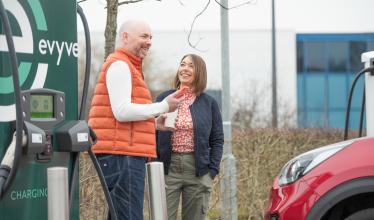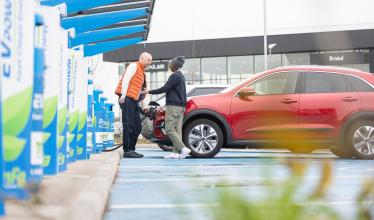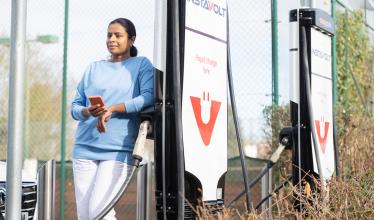Whether you've just got an electric car, you’re considering getting one, or you’re a long-time EV driver, you’re in the right place to find out all you need to know about electric car charging costs.
Electric car charging costs: Where to start
Your first step is to be intrigued, because the switch to electric transport is really exciting. We’ve not witnessed a shift as big as this since people started driving petrol-powered ‘autocars’ in the late 1800s. Unlike driving a petrol or diesel vehicle, the cost to charge your electric car can vary quite a bit – and for a few different reasons.
So here we’ve broken things down for you in a few different ways. Below you’ll find:
- How to find out how much it costs to charge your EV
- What factors affect electric car charging costs
- Why it can sometimes cost a lot to charge an electric car on the public network
- When the best times are to charge and keep costs down
- What the cost of charging an electric car might look like in future
How do I find out how much it costs to charge my electric car?
If you haven’t already, download the Zapmap app to get started. Take a look at the charge points in your area to get an idea of the costs across the different charger types and speeds. The app also displays multiple different pricing options per location where applicable, which we show thanks to our direct links with charge point operators.
You can narrow down your search further using our pricing filter by upgrading to Zapmap Premium. This will allow you to set your preferred price range per kWh.
Interested in pricing trends and scenarios? Take a look at the Zapmap Price Index or our monthly tracker of top 10 rapid charging network prices.
You can also use our EV charging cost calculators to easily calculate public and home charging costs, plus journey costs and tax calculations.
What are the differences in electric car charging costs?
There are various different factors that affect the cost of charging an electric car, from when you charge it and where you charge it (home or away) through to the type of charge point you use and the payment method you choose.
Public charging costs
The power rating of a charge point is usually the main factor in the cost of public charging. Generally speaking, the higher the power type, the more expensive the cost per kWh. In essence, you are paying more for the convenience of a shorter charging time as the power will be delivered at a higher rate.
Ultra-rapid charge points on the public network are typically priced at 79p/kWh, whereas slower charging can range anywhere between free-to-use and around 57p/kWh.
Electric car charging costs can also vary depending on how you pay for EV charging. The convenience of pay-as-you-go charging via contactless payment can mean missing out on discount rates via charge point operator’s own apps where they might offer lower costs to charge for users who are signed up to a membership.
Roaming providers often give discounts to their members also, including Zapmap Premium subscribers, who get a 5% charging discount when they pay via Zap-Pay.
Just looking for a ballpark figure to manage your monthly budget or to put your mind at ease? Try out our public charging calculator, simply input your electric car details and the details of the charge point you plan to use and you’ll get a quick estimate of the costs involved in charging your EV either fully or to your preferred percentage.
Want to compare the cost of charging an electric car car to the price of filling up with petrol or diesel? Try out our journey cost calculator to see the difference between fuel types in price per mile.
Home charging costs
Charging at home is the most cost-efficient way to ‘fill up’ your electric car. The cost can vary significantly depending on a few factors, including your energy tariff, and the time of day you charge.
Many electricity suppliers offer time-of-use tariffs that provide cheaper rates of electricity during off-peak periods, such as overnight. By scheduling your charging to coincide with the off-peak pricing, you could save money. Smart charging technology can automate this process for you, ensuring your EV charges at the most economical times without you having to manually start every charging session.
Good Energy has launched an EV tariff which will help electric car drivers to charge both at home and on the go thanks to a free Zapmap Premium subscription offer.
To get a rough idea of the cost to charge at home, try out our home charging calculator.

Why does it cost so much to charge an electric car on the public network?
Public charging stations usually charge for electricity at a higher rate than home charging due to several factors. Firstly, the infrastructure and maintenance of EV chargers requires investment from charge point operators (CPOs).
Secondly, the consolidation of prices at higher levels in public charging can be seen in the context of uncertainty in wholesale energy prices . Unlike residential charging costs, commercial businesses do not have a set price cap for the rate at which they charge consumers for energy to charge an EV. However, businesses are investing so that there's more funding going into the creation of higher power hubs to future-proof the charging network ready for ZEV mandate implementation - when the sale of new petrol and diesel vehicles will be banned. Osprey Charging CEO Ian Johnston explains how this investment and current changing costs correlate in a discussion with Zapmap Co-founder and CEO, Melanie Shufflebotham in this video.
Lastly, a major factor behind the cost has been a change to the grid code that means operators are having to absorb standing charges that are, in some cases, 10 times what they were two years ago. In some cases this means CPOs are operating at a loss, but hope to recover these costs in future when utilisation of their charge points is higher.
Keeping costs down: The best time to charge an electric car
We’ve covered a little about off-peak home charging above in the Home charging costs section, but what about on the public network?
Many CPOs will provide lower costs to charge during less busy periods. The Tesla Supercharger network is a great example of this, where flexible pricing is available to its members, regardless of the EV they drive. Tesla delivers off-peak charging at 54p/kWh for most of the day, but increases to 67p/kWh between 4pm-8pm.
Other CPOs offer seasonal deals, or membership discounts, but many have similar set rates by time of day for pay-as-you-go customers also.
Electric car charging costs: What does the future hold?
Campaign groups such as FairCharge are lobbying the Government to reduce the VAT on public charging from 20% to 5% to bring it in line with domestic charging costs, but the government is yet to make a decision.
Thanks to our charging Price Index – which shows the difference in prices paid depending on the type of charger and how this is changing over time – we know that prices to charge on the public network continued to increase during 2023, but at a much lower rate than we saw in 2022. So we can expect charging prices to continue to increase through to the start of 2025, but hopefully the slower rate of increase will be maintained.





